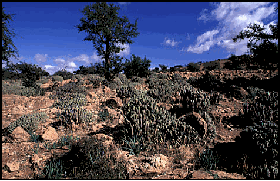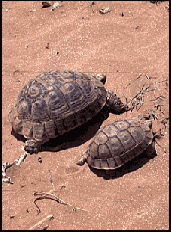|
The natural habitat of Testudo graeca graeca includes semi-arid scrub and Mediterranean forest, to the verges of semi-desert, where it can be found inhabiting outcrops of succulent Euphorbia. This habitat is subject to marked seasonal fluctuations in vegetation - with peak availability of edible plants in winter and early spring. In southern areas, T. g. graeca is active throughout the warm winter period, and estivates through the hot summer. In northern areas of its range, this cycle is reversed with a winter hibernation and summer activity period. In captivity, this tortoise requires a spacious, dry, well drained pen with adequate natural graze. Fresh water should be available at all times. This species is in no way suitable for exclusive indoor maintenance in vivarium tanks. It is highly inadvisable to mix T. g. graeca with other species - including other members of the same genus. They are extremely susceptible to 'alien' pathogens and are notoriously difficult to cure of 'Runny Nose' problems once they commence. Under no circumstances provide animal protein, or other high protein, high fat foods to Testudo graeca. Although recommended in some outdated texts, to do so invites terminal renal problems and, in the case of juveniles, will lead to artificially accelerated growth and guaranteed Metabolic Bone Disease (e.g., 'lumpy shell syndrome'). Provide a diet comprised of as many freshly picked wild foods as possible, and use a quality calcium and multi-vitamin supplement daily. For further details on the dietary management of Testudo species, please consult the Tortoise Trust's "Feeding Manual". If cared for correctly, Testudo graeca can reach extreme ages in captivity - we are aware of several which have surpassed 100 years. Hibernation is a very critical time, so please read the Tortoise Trust's "Safer Hibernation and Your Tortoise" to avoid potentially fatal errors.
|
|




